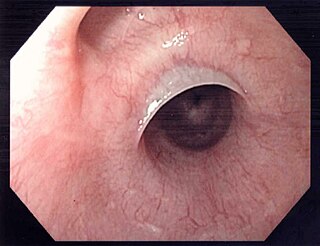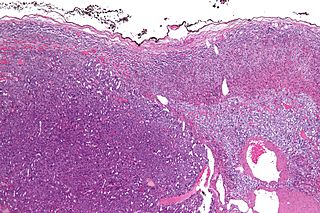
Interstitial cystitis (IC), also known as bladder pain syndrome (BPS), is a type of chronic pain that affects the bladder. Symptoms include feeling the need to urinate right away, needing to urinate often, and pain with sex. IC/BPS is associated with depression and lower quality of life. Many of those affected also have irritable bowel syndrome and fibromyalgia.

Temporomandibular joint dysfunction is an umbrella term covering pain and dysfunction of the muscles of mastication and the temporomandibular joints. The most important feature is pain, followed by restricted mandibular movement, and noises from the temporomandibular joints (TMJ) during jaw movement. Although TMD is not life-threatening, it can be detrimental to quality of life, because the symptoms can become chronic and difficult to manage.

Compartment syndrome is a condition in which increased pressure within one of the body's anatomical compartments results in insufficient blood supply to tissue within that space. There are two main types: acute and chronic. Compartments of the leg or arm are most commonly involved.

Head and neck cancer is a group of cancers that starts in the mouth, nose, throat, larynx, sinuses, or salivary glands. Symptoms for head and neck cancer may include a lump or sore that does not heal, a sore throat that does not go away, trouble swallowing, or a change in the voice. There may also be unusual bleeding, facial swelling, or trouble breathing.

Lichen planus is a chronic inflammatory and immune mediated disease that affects the skin, nails, hair, and mucous membranes. It is characterized by polygonal, flat-topped, violaceous papules and plaques with overlying, reticulated, fine white scale, commonly affecting dorsal hands, flexural wrists and forearms, trunk, anterior lower legs and oral mucosa. Although there is a broad clinical range of LP manifestations, the skin and oral cavity remain as the major sites of involvement. The cause is unknown, but it is thought to be the result of an autoimmune process with an unknown initial trigger. There is no cure, but many different medications and procedures have been used in efforts to control the symptoms.
Plummer–Vinson syndrome is a rare disease characterized by difficulty swallowing, iron-deficiency anemia, glossitis, cheilosis and esophageal webs. Treatment with iron supplementation and mechanical widening of the esophagus generally provides an excellent outcome.

Esophageal webs are thin membranes occurring anywhere along the esophagus.

Adrenocortical carcinoma (ACC) is an aggressive cancer originating in the cortex of the adrenal gland.
Couvade syndrome, also called sympathetic pregnancy, is a proposed condition in which a partner experiences some of the same symptoms and behavior as an expectant mother. These most often include minor weight gain, altered hormone levels, morning nausea, and disturbed sleep patterns. In more extreme cases, symptoms can include labor pains, fatigue, postpartum depression, and nosebleeds. The labor pain symptom is commonly known as sympathy pain.

Macroglossia is the medical term for an unusually large tongue. Severe enlargement of the tongue can cause cosmetic and functional difficulties in speaking, eating, swallowing and sleeping. Macroglossia is uncommon, and usually occurs in children. There are many causes. Treatment depends upon the exact cause.
Burning mouth syndrome (BMS) is a burning sensation in the mouth with no underlying known dental or medical cause. No related signs of disease are found in the mouth. People with burning mouth syndrome may also have a subjective xerostomia, paraesthesia, or an altered taste or smell.
Pseudo-Cushing's syndrome is a medical condition in which patients display the signs, symptoms, and abnormal hormone levels seen in Cushing's syndrome. However, pseudo-Cushing's syndrome is not caused by a problem with the hypothalamic-pituitary-adrenal axis as Cushing's is; it is mainly an idiopathic condition, however a cushingoid appearance is sometimes linked to excessive alcohol consumption. Elevated levels of total cortisol can also be due to estrogen found in oral contraceptive pills that contain a mixture of estrogen and progesterone. Estrogen can cause an increase of cortisol-binding globulin and thereby cause the total cortisol level to be elevated.
Postcholecystectomy syndrome (PCS) describes the presence of abdominal symptoms two years after a cholecystectomy.

Nasopharynx cancer is the most common cancer originating in the nasopharynx, most commonly in the postero-lateral nasopharynx or pharyngeal recess, accounting for 50% of cases. NPC occurs in children and adults. NPC differs significantly from other cancers of the head and neck in its occurrence, causes, clinical behavior, and treatment. It is vastly more common in certain regions of East Asia and Africa than elsewhere, with viral, dietary and genetic factors implicated in its causation. It is most common in males. It is a squamous cell carcinoma of an undifferentiated type. Squamous epithelial cells are a flat type of cell found in the skin and the membranes that line some body cavities. Differentiation means how different the cancer cells are from normal cells. Undifferentiated cells are cells that do not have their mature features or functions.

Salivary gland tumours or neoplasms are tumours that form in the tissues of salivary glands. The salivary glands are classified as major or minor. The major salivary glands consist of the parotid, submandibular, and sublingual glands. The minor salivary glands consist of 800-1000 small mucus-secreting glands located throughout the lining of the oral cavity.
Urologic diseases or conditions include urinary tract infections, kidney stones, bladder control problems, and prostate problems, among others. Some urologic conditions don't affect a person for that long and some are lifetime conditions. Kidney diseases are normally investigated and treated by nephrologists, while the specialty of urology deals with problems in the other organs. Gynecologists may deal with problems of incontinence in women.
There are several forms of Epstein–Barr virus (EBV) infection. These include asymptomatic infections, the primary infection, infectious mononucleosis, and the progression of asymptomatic or primary infections to Epstein-Barr virus-associated lymphoproliferative diseases such as Burkitt's lymphoma, chronic active EBV infection, and the types types II and III pharyngeal carcinomas or Epstein-Barr virus-associated non-lymphoproliferative diseases such as some cases of the immune disorders of multiple sclerosis and systemic lupus erythematosis; malignancies such as stomach cancers, soft tissue sarcomas, leiomyosarcoma, and undifferentiated type I nasopharyngeal cancer; and the childhood disorders of Alice in Wonderland Syndrome and acute cerebellar ataxia.

Jugular foramen syndrome, or Vernet's syndrome, is characterized by paresis of the glossopharyngeal, vagal, and accessory nerves.
In the pharynx, the sinus of Morgagni is the enclosed space between the upper border of the superior pharyngeal constrictor muscle, the base of the skull and the pharyngeal aponeurosis.
Temporal lobe necrosis is a late-stage and serious complication usually occurring in persons who have undergone radiation treatment for nasopharyngeal carcinoma (NPC). It is rather rare and occurs in 4-30% of patients who receive radiation treatment for NPC. Many patients who experience temporal lobe necrosis are asymptomatic. This demonstrates a need for consistent imaging follow up, such as MRI and/or PET/CT, to help with the potential management of it. Those who are symptomatic usually suffer from "vague" symptoms including headaches, dizziness, intracranial pressure, personality changes, seizures, and short-term memory loss. The rarity of this disease has led to difficulty in finding optimal treatments, however, most treatments include one or some of the following: steroids, hyperbaric oxygen, surgery, and decadron.












